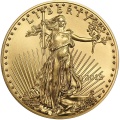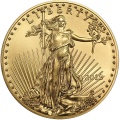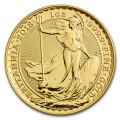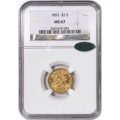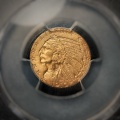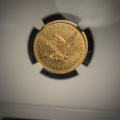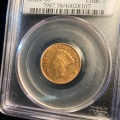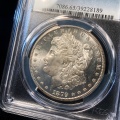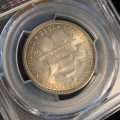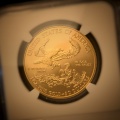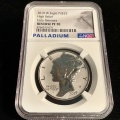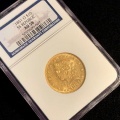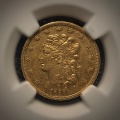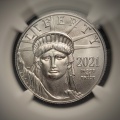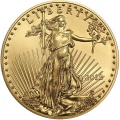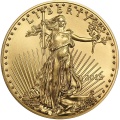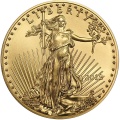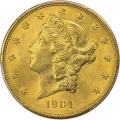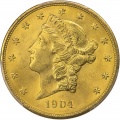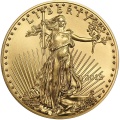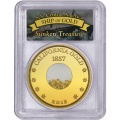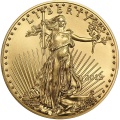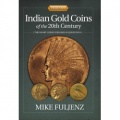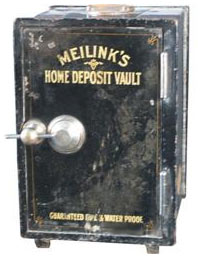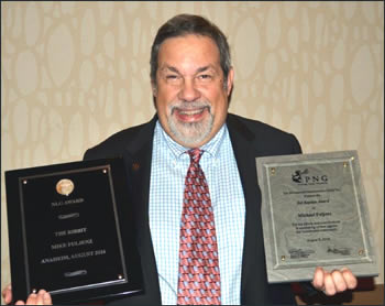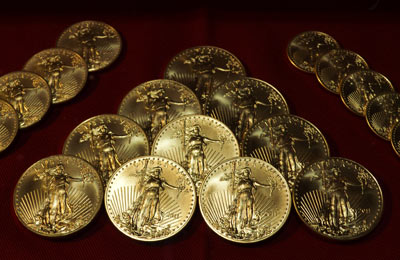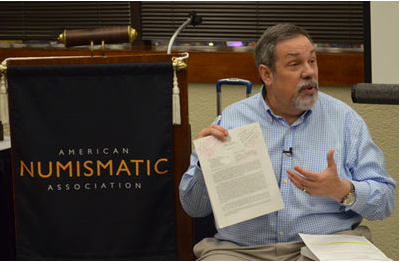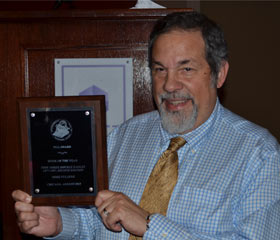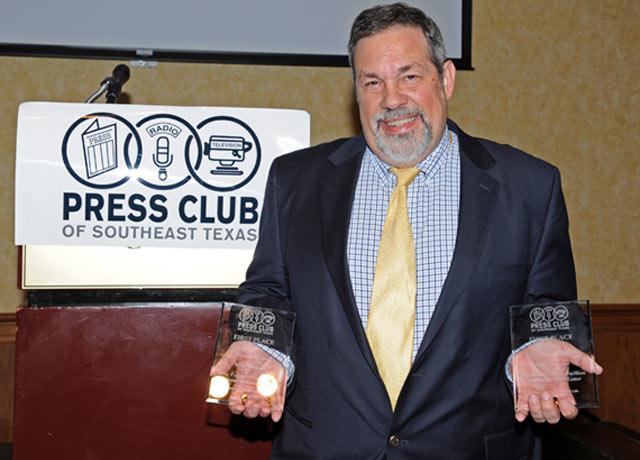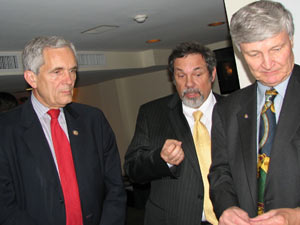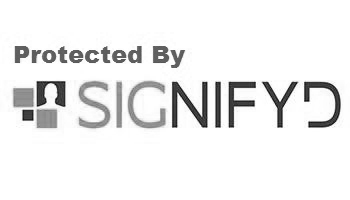June 2018 - Week 2 Edition
The Silver American Eagle – A Perfect “Flag Day” Purchase
With America’s Flag Day coming this Thursday, the classic design of the Silver American Eagle makes the perfect gift, keepsake and reminder of America’s greatness – and also a preferred investment in silver. These Silver Eagles were approved for production by Congress in 1985 at the beginning of Ronald Reagan’s second term, after he was re-elected in a landslide on the campaign slogan, “It’s Morning in America.” The first American Silver Eagles were struck in 1986.
The coin’s two sides comprise a classic design combination. The obverse (front) is based on sculptor Adolph A. Weinman’s classic “Walking Liberty” design first popularized on the American silver half dollar in 1916, with Miss Liberty draped in an American flag. The reverse depicts a heraldic eagle, a time-honored American symbol rendered by Chief Engraver John Mercanti. Each coin contains one full Troy ounce of .999-fine silver with guaranteed weight and purity.
In this day and age when standing for the American Flag and National Anthem is unfortunately controversial, we stand for both, and you can stand for both by giving family and friends special silver bars in the form of the American flag or American Silver Eagles with Miss Liberty proudly draped in Stars and Stripes.
The Origin of “Flag Day” in America
“Resolved, that the flag of the 13 United States be 13 stripes, alternate red and white; that the union be 13 stars, white on a blue field, representing a new constellation… White signifies Purity and Innocence; Red, Hardiness and Valor; Blue signifies Vigilance, Perseverance and Justice.”
-- By Act of Congress, June 14, 1777.
While Flag Day has never been an official holiday, many Americans have honored America by raising a U.S. flag in their home or place of business on June 14. The idea of an annual day to celebrate the Flag is believed to have originated with a 19-year-old school teacher, Bernard J. Cigrand, who arranged for his students in the Fredonia, Wisconsin Public School to observe June 14, 1885 as “Flag Birthday.” He then went on to dental school, but he began to publish articles in magazines and newspapers in the following years arguing for the observance of June 14 as “Flag Birthday,” which he later shortened to “Flag Day.”
His idea quickly caught on. On June 14, 1889, George Balch, a kindergarten teacher in New York City, planned appropriate ceremonies for the children of his school. On June 14, 1891, the Betsy Ross House in Philadelphia held a Flag Day celebration. In 1894, the governor of New York directed that the Flag be displayed on all public buildings on June 14. With B.J. Cigrand as the founding spirit, the Illinois-based American Flag Day Association was organized and held a city-wide public-school children's celebration of Flag Day in all of Chicago’s major public parks in 1894, with over 300,000 children participating.
After three decades of such state and local celebrations, Flag Day was finally recognized nationally by a Proclamation from President Woodrow Wilson on May 30, 1916. It was not until August 3, 1949, that President Truman signed an Act of Congress designating June 14th of each year as National Flag Day.
Flag Day has become an important day to stage some important national events, like these:
On June 14, 1922, President Warren Harding became the first U.S. president to broadcast on live radio. He chose Flag Day in order to dedicate the Francis Scott Key Memorial in Baltimore, Maryland.
On June 14, 1927, a large American flag was placed in the right hand of the Statue of Liberty the day after Charles Lindbergh received a ticker-tape parade and a Distinguished Flying Cross.
On June 14, 1954, President Eisenhower signed an order adding “Under God” to the Pledge of Allegiance.
And, just by coincidence, President Donald J. Trump was born on June 14, 1946.
A STAR-SPANGLED TRIBUTE TO ‘IN GOD WE TRUST’
Exactly half a century before the motto “In God We Trust” first appeared on circulating U.S. coinage, a close approximation of this now-famous phrase turned up in a poem that went on to attain equally iconic status when it was set to music and became “The Star-Spangled Banner.” Few Americans are aware of this precursor, for the words are embedded in the seldom read – and almost never sung – fourth stanza of the poem, but it provides a fascinating link between their country’s official national motto and official national anthem.
Actually, it’s much more than just a “link.” The words in “The Star-Spangled Banner” served, in fact, as a model and inspiration for the motto that ended up on U.S. coins and, eventually, U.S. paper money. This was confirmed in a document written in 1863 by James Pollock, Director of the United States Mint, a well-respected public official who had served previously as both Governor of Pennsylvania and a Congressman from that state.
Pollock was a close friend of President Abraham Lincoln and, like Lincoln, had been active in the antislavery movement in the years leading up to the Civil War. He was a pious man whose strong religious beliefs led people to call him “The Great Christian Governor.” His role in selecting the phrase that expressed Americans’ faith in God resulted from a directive he received from a fellow-Pennsylvanian, Treasury Secretary Salmon P. Chase, during the first year of the War Between the States.
“The trust of our people in God should be declared on our national coins,” Chase told the Mint Director. “You will cause a device to be prepared without unnecessary delay with a motto expressing in the fewest tersest terms possible this national recognition.”
After studying the subject, Pollock wrote to Chase as follows:
“The motto suggested, ‘God our Trust,’ is taken from our National Hymn, ‘The Star-Spangled Banner.’ The sentiment is familiar to every citizen of our country; it has thrilled the hearts and fallen in song from the lips of millions of American Freemen. The time for the introduction of this or a similar motto, is propitious and appropriate. ’Tis an hour of National peril and danger, an hour when man’s strength is weakness, where our strength and our nation’s strength and salvation must be in the God of battles and of nations. Let us reverently acknowledge his sovereignty, and let our coinage declare our trust in God.”
In the penultimate sentence of “The Star-Spangled Banner,” those who read – or sing – the entire set of lyrics will find the words that inspired Pollock’s choice for a short but powerful reference to the Almighty:
Then conquer we must, when our cause is just,
And this be our motto: “In God is our trust.”
The search for a suitable coinage motto began in late 1861, six months after hostilities commenced in the bloody Civil War, when Treasury Secretary Chase received a letter from the Rev. Mark R. Watkinson, a Baptist minister from Ridleyville, Pa., urging that provision be made for “the recognition of the Almighty God in some form on our coins.”
Several different mottoes – including “God our Trust” – were considered for use on U.S. coinage before officials settled upon “In God We Trust” for placement on the new bronze two-cent piece in 1864. Chase set in motion the steps that led to this affirmation of faith because he, like Watkinson and Pollock, considered it important to profess the nation’s trust in a higher being at a time of such turmoil and travail.
“The Star-Spangled Banner” was written by Francis Scott Key in 1814, shortly before the end of the War of 1812 between the fledgling United States and its former mother country, Great Britain. Key was a lawyer from Washington, D.C., who had gone to Baltimore to negotiate the release of an American civilian – a Maryland physician named Dr. William Beanes, who was being held as a prisoner of war on a British ship in Chesapeake Bay.
Key and another American negotiator, John S. Skinner, were on a truce ship on the morning of Sept. 13, 1814, when British warships in the bay launched a 25-hour bombardment of Fort McHenry, which guarded Baltimore Harbor. The British had detained the envoys lest, on their return, they would disclose details of the then-pending attack – so Key was forced to witness the fearsome onslaught from a powerless position on the British side of the fray.
His frustration turned to euphoria when the dawn’s early light on the following day, Sept. 14, revealed that the large, newly sewn U.S. flag atop Fort McHenry had emerged intact from the perilous fight and the British were forced to withdraw because they were running low on ammunition. Today, that flag is prominently displayed at the Smithsonian Institution’s National Museum of American History in Washington, D.C., and never fails to inspire the constant stream of visitors.
Fort McHenry’s defenders had repulsed the attack after a night suffused by rockets’ red glare and punctuated by constant volleys of bombs bursting in air. All these sights and sounds inspired Key, a poet by avocation, to compose some verses of patriotic homage to the drama he had beheld. He started making notes aboard ship – and by the time he set foot on land, he was already immersed in writing a poem he called “Defence of Fort McHenry.” He completed all four stanzas within a day at the Baltimore inn where he was staying. The poem was published in the Baltimore Patriot on Sept. 20, 1814, six days after the end of the British bombardment.
Evidence suggests that Key himself suggested setting his poem to music by using the melody of a song called “To Anacreon in Heaven,” which was written nearly four decades earlier by a British composer and organist named John Stafford Smith. It is frequently reported that “The Star-Spangled Banner” is set to the music of a British drinking song. This is technically correct, but it conjures up visions of a rowdy British pub – and this is an inaccurate perception.
Smith, a highly regarded musicologist, composed the music in the mid-1770s for the official song of an elite group of gentlemen called the Anacreontic Society whose distinguished members – including Samuel Johnson and James Boswell – shared stimulating conversations over fine food and drink. A typical meeting included a formal concert, a sumptuous dinner and social time during which members regaled each other with stories, jokes and songs. The society took its name from Anacreon, a sixth-century Greek poet who wrote odes on the pleasures of wine and love, and the song’s original lyrics were written by the organization’s president, Ralph Tomlinson, who apparently commissioned Smith to write the music.
Like many familiar tunes of that time, Smith’s melody – lacking copyright protection – was liberally “borrowed” for use with other verses totally unrelated to its original purpose. In 1798, for example, it was used in a popular parody praising the second U.S. President, John Adams, titled “Adams and Liberty – The Boston Patriot Song.” After Thomas Jefferson thwarted Adams’ re-election bid in 1800, the melody got a new set of lyrics in a version titled “Jefferson and Liberty.” Francis Scott Key was clearly familiar with the music, for he used it himself to accompany one of his poems in 1805. The poem, “When the Warrior Returns,” honored U.S. heroes of the First Barbary War with North African pirates.
During the century after its words were written, “The Star-Spangled Banner” came to be widely viewed as the national hymn, as it was described by Mint Director Pollock. It didn’t attain that status officially, however, until the early part of the 20th century. In 1916, with the Great War (later renamed World War I) raging in Europe and American involvement a growing possibility, President Woodrow Wilson issued an executive order proclaiming the song to be the national anthem. This had little effect beyond requiring military bands to play it at public performances. The song’s official status was finally solidified 15 years later, in 1931, when Congress passed a legislation formally declaring it to be the national anthem. The legislation was signed by President Herbert Hoover.
A quarter-century later, on July 30, 1956, President Dwight D. Eisenhower signed legislation establishing “In God We Trust” as the nation’s only official motto. Sentiment favoring adoption of this motto had been building since the end of World War II, a conflict which – like the Civil War – caused many Americans to turn to a higher power for guidance, solace and hope. A year earlier, in 1955, Congress had approved the insertion of the words “under God” into the Pledge of Allegiance and mandated use of “ln God We Trust” on all U.S. paper money.
Despite the publicity surrounding these events, many Americans continue to believe the official national motto is “E Pluribus Unum.” A case in point came to light during construction of the Capitol Visitors Center, a three-level, 580,000-square-foot “waiting room” for tourists beneath the U.S. Capitol in Washington, D.C. Initially, a plaque was placed there declaring “E Pluribus Unum” to be the official U.S. motto. But once the mistake was discovered, Congress ordered the plaque replaced by a new one, still in place, that correctly identifies “In God We Trust” as the national motto. This serves as highly visible confirmation, in a major public building, of the latter motto’s official status and stature.
President Obama showed similar ignorance about “ln God We Trust“ – and lack of appreciation for how meaningful it is for many Americans – in 2011, when he incorrectly identified “E Pluribus Unum” as the national motto, then dismissed congressional critics when they overwhelmingly passed a resolution, 396 to 9, setting the record straight. The resolution was sponsored by Congressman Randy Forbes, a Republican from Virginia. It supported and encouraged the display of the words “In God We Trust” in all public schools and government buildings.
The fourth stanza of “The Star-Spangled Banner” is unlikely to be heard at the start of baseball games and other sporting events, where many restless fans cheer even the opening stanza prematurely, as if to signal: “Play ball!” For those with greater patience, though, the words of trust in God provide an opportunity to pause and reflect on America’s long tradition of seeking divine guidance to steer the Ship of State through troubled waters – waters such as those two centuries ago in Baltimore Harbor.
For those inclined to sing the final stanza, here are the words of Francis Scott Key:
O, thus be it ever when freemen shall stand,
Between their lov’d homes and the war’s desolation;
Blest with vict’ry and peace, may the heav’n-rescued land
Praise the Pow’r that hath made and preserv’d us a nation!
Then conquer we must, when our cause is just,
And this be our motto: “In God is our trust.”
And the star-spangled banner in triumph shall wave
O’er the land of the free and the home of the brave!
Important Disclosure Notification: All statements, opinions, pricing, and ideas herein are believed to be reliable, truthful and accurate to the best of the Publisher's knowledge at this time. They are not guaranteed in any way by anybody and are subject to change over time. The Publisher disclaims and is not liable for any claims or losses which may be incurred by third parties while relying on information published herein. Individuals should not look at this publication as giving finance or investment advice or information for their individual suitability. All readers are advised to independently verify all representations made herein or by its representatives for your individual suitability before making your investment or collecting decisions. Arbitration: This company strives to handle customer complaint issues directly with customer in an expeditious manner. In the event an amicable resolution cannot be reached, you agree to accept binding arbitration. Any dispute, controversy, claim or disagreement arising out of or relating to transactions between you and this company shall be resolved by binding arbitration pursuant to the Federal Arbitration Act and conducted in Beaumont, Jefferson County, Texas. It is understood that the parties waive any right to a jury trial. Judgment upon the award rendered by the Arbitrator may be entered in any court having jurisdiction thereof. Reproduction or quotation of this newsletter is prohibited without written permission of the Publisher.


